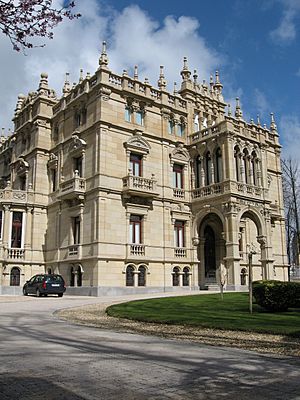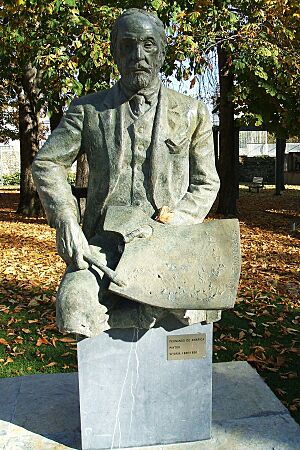Augustin Zulueta Palace facts for kids
Quick facts for kids Augustin Zulueta Palace |
|
|---|---|
| Native name Spanish: Palacio Augustín Zulueta |
|
 |
|
| Location | Vitoria, Spain |
| Built | 1912 |
| Architect | Julián Apraiz and Javier Luque |
| Architectural style(s) | Historicist |
| Governing body | Regional Council of Álava |
| Official name: Palacio Augustin | |
| Type | Non-movable |
| Criteria | Monument |
| Designated | 1962 |
| Reference no. | RI-51-0001300 |
| Lua error in Module:Location_map at line 420: attempt to index field 'wikibase' (a nil value). | |
The Augustin Zulueta Palace is a historic building in the city of Vitoria-Gasteiz, Spain. It was built over 100 years ago to be a family home. Today, it is the home of the Museum of Fine Arts of Álava.
The palace was designed in 1912 by the architects Julián de Apraiz and Javier Luque. They were famous for also designing the city's New Cathedral. The palace is an important landmark and was declared a Bien de Interés Cultural in 1962. This is a special title given to protect important Spanish heritage sites.
The museum inside the palace displays Spanish art from the 17th to the 20th centuries. It also has a large collection of Basque art from 1850 to 1950.
Contents
History of the Palace
A Home for a Family
In 1912, a married couple named Elvira Zulueta and Ricardo de Augustin decided to build a grand home. Elvira came from a wealthy family. They chose a beautiful spot in Vitoria-Gasteiz for their new palace.
They hired the best architects in the city, Javier Luque and Julián de Apraiz, to design their home. The palace was finished in 1916, and the couple moved in. Sadly, Elvira died just a year later in 1917, and Ricardo eventually left the city.
Because the couple had no children, the palace was given to the Catholic Church. A few years later, in 1924, Ricardo made a deal with the church to become the owner again.
From a Home to a Museum
In 1941, the Regional Council of Álava, the local government, bought the palace. They wanted to turn it into a museum for fine art and archaeology. The new museum gathered art from many places. It received religious art from the church, other artworks from the famous Museo del Prado in Madrid, and local paintings.
In the 1960s, the museum agreed to display the works of an artist named Fernando de Amárica. To make space for his art, a new section was added to the palace in 1965.
Starting in 1975, the museum began collecting contemporary art, which is art made in modern times. This collection grew over the years and is now considered one of the best in Spain. Today, the palace continues to be the city's Museum of Fine Arts.
The Palace's Architecture
The Augustin Zulueta Palace is a great example of historicist architecture. This style mixes ideas from different historical periods. The building has a square shape and is surrounded by a large, beautiful garden.
The palace has a basement and three main floors. The front of the building has a grand entrance with arches. Above the entrance, there is a glass-covered room and a coat of arms carved in stone.
Additions and Changes
A new section was added to the museum in the 1960s. It was designed by an architect named Jesús Guinea. This new part connects to the main building but has a simple style so it doesn't take away from the original palace's beauty.
The palace has been carefully restored over the years. In 2000, a new entrance was built to make it easier for people with disabilities to visit. This modern entrance is a cube made of glass and wood, which leads visitors into the historic building.
See also
 In Spanish: Palacio de Augustín-Zulueta para niños
In Spanish: Palacio de Augustín-Zulueta para niños


